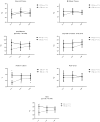Eleven Weeks of Iron Supplementation Does Not Maintain Iron Status for an Entire Competitive Season in Elite Female Volleyball Players: A Follow-Up Study
- PMID: 30336598
- PMCID: PMC6213587
- DOI: 10.3390/nu10101526
Eleven Weeks of Iron Supplementation Does Not Maintain Iron Status for an Entire Competitive Season in Elite Female Volleyball Players: A Follow-Up Study
Abstract
Background: Even though iron supplementation can be effective, it is necessary to be cautious of toxicity and aim to do no harm, therefore, it is important to examine the length of time the benefits of iron supplementation can be maintained following its cessation. The main purpose of this study was to analyze if iron stores and strength performance were maintained in elite female volleyball players for the final 18 weeks of a competitive season following the cessation of 11 weeks of iron supplementation.
Methods: Twenty-two volleyballers (age: 27.0 ± 5.6 years.) were assigned to two groups (iron treatment group-ITG, n = 11 or control gropu-CG, n = 11) at the beginning of a previous trial (T0) and ITG consumed 325mg/d of ferrous sulphate for 11 weeks (T11). Then, in the present study iron status and strength were measured again 10 (T21) and 18 weeks later (T29) after the cessation of supplementation.
Results: At the end of the previous trial (T11), ITG maintained iron status as measured by hematological parameters (serum iron-sFE, serum ferritin-FER, transferrin saturation index-TSI, and hemogloblin-Hb), however, CG showed a decrease in these markers at T11. Further, from T0 to T11 ITG experienced greater (p < 0.05) changes in clean and jerk, power clean, and total mean strength (TMS-sum of all strength tests) than CG. In the present, follow-up investigation, there was a group-by-time interaction in favor of CG vs. ITG from T11 to T21 for FER (p = 0.028) and Hb (p = 0.042). Further, there was an increase for CG (p < 0.001) in power clean for CG from T11 (38.4 ± 1.7 kg) to T21 (41.3 ± 1.9 kg) and T29 (41.8 ± 1.7 kg), but no change for power clean in ITG (p > 0.05). A group-by-time interaction from T11 to T29 occurred in favor of CG for half-squat (p = 0.049) and TMS (p = 0.049).
Conclusion: Our findings suggest that the benefits of iron supplementation are not sustained in elite female volleyballers if supplementation is ceased for 18 weeks.
Keywords: exercise; female; health; iron supplementation; volleyball eleven weeks of iron supplementation does not maintain iron status for an entire competitive.
Conflict of interest statement
The authors declare no conflict of interest.
Figures




Similar articles
-
Iron supplementation prevents a decline in iron stores and enhances strength performance in elite female volleyball players during the competitive season.Appl Physiol Nutr Metab. 2015 Jun;40(6):615-22. doi: 10.1139/apnm-2014-0500. Epub 2015 Feb 10. Appl Physiol Nutr Metab. 2015. PMID: 25965846 Clinical Trial.
-
Dietary intake habits and controlled training on body composition and strength in elite female volleyball players during the season.Appl Physiol Nutr Metab. 2015 Aug;40(8):827-34. doi: 10.1139/apnm-2015-0100. Epub 2015 Apr 21. Appl Physiol Nutr Metab. 2015. PMID: 26224330
-
Effect of Iron Supplementation on the Modulation of Iron Metabolism, Muscle Damage Biomarkers and Cortisol in Professional Cyclists.Nutrients. 2019 Feb 27;11(3):500. doi: 10.3390/nu11030500. Nutrients. 2019. PMID: 30818782 Free PMC article. Clinical Trial.
-
Calcium supplementation and iron status of females.Nutrition. 2001 Jan;17(1):46-51. doi: 10.1016/s0899-9007(00)00482-2. Nutrition. 2001. PMID: 11165888 Review.
-
Refining Treatment Strategies for Iron Deficient Athletes.Sports Med. 2020 Dec;50(12):2111-2123. doi: 10.1007/s40279-020-01360-2. Sports Med. 2020. PMID: 33057935 Review.
Cited by
-
Putting the Fe into Female Athletes: Insights into Heightened Iron Status and Women's Australian Football Performance-A Case Study.Sports (Basel). 2025 Apr 29;13(5):136. doi: 10.3390/sports13050136. Sports (Basel). 2025. PMID: 40423272 Free PMC article.
-
Effect of baseline ferritin levels on post-exercise iron metabolism in male elite youth rowers.Sci Rep. 2025 Jul 2;15(1):23440. doi: 10.1038/s41598-025-07682-3. Sci Rep. 2025. PMID: 40603565 Free PMC article.
-
Iron Status and Physical Performance in Athletes.Life (Basel). 2023 Oct 2;13(10):2007. doi: 10.3390/life13102007. Life (Basel). 2023. PMID: 37895389 Free PMC article. Review.
-
Iron and Physical Activity: Bioavailability Enhancers, Properties of Black Pepper (Bioperine®) and Potential Applications.Nutrients. 2020 Jun 24;12(6):1886. doi: 10.3390/nu12061886. Nutrients. 2020. PMID: 32599787 Free PMC article. Review.
-
Effect of Off-Season Iron Supplementation on Aerobic Capacity of Female Handball Player: A Randomized, Double-Blinded, Placebo-Controlled Study.Curr Dev Nutr. 2024 May 8;8(6):103767. doi: 10.1016/j.cdnut.2024.103767. eCollection 2024 Jun. Curr Dev Nutr. 2024. PMID: 38868615 Free PMC article.
References
-
- Mielgo-Ayuso J., Urdampilleta A., Martinez-Sanz J.M., Seco J. Dietary Iron Intake and Deficiency in Elite Women Volleyball Players. Nutr. Hosp. 2012;27:1592–1597. - PubMed
Publication types
MeSH terms
Substances
LinkOut - more resources
Full Text Sources
Medical

